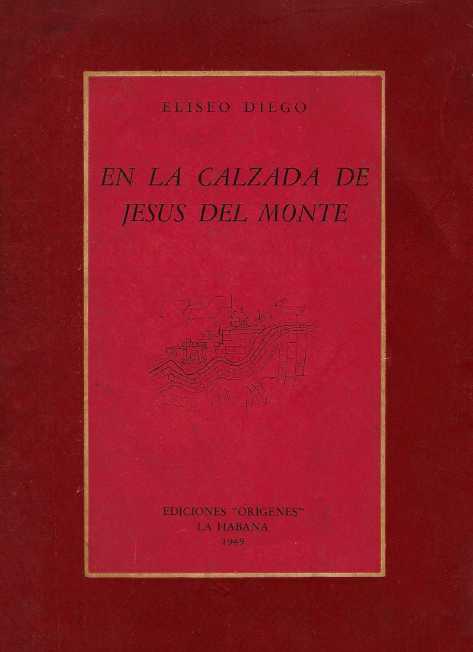4.1.2.7.1 “On the road of Jesús del Monte”, first poetic text by Eliseo Diego (1920 – 1994)

“On the Calzada de Jesús del Monte,” from 1949, was the first poetic text in book form published by Eliseo Diego, which constituted a revelation in the Origenist world, with repercussions throughout the national poetic scene. The booklet received praise from the main members of Orígenes, including José Lezama Lima, who expressed clear joy at the advent of poetry of greater substance than that of preceding generations.
This collection of poems is also a notable example of the Spanish language and its intrinsic poetic qualities, which Eliseo Diego translates into a juice that is that of the word as material, but in which reality and vitality are perceived above any verbal arabesque. The language has a certain cultured quality but is adaptable to Diego’s poetic patience and his desire to sculpt aesthetic forms with an enduring voice.
According to Cintio Vitier, perhaps the most astute critic of Eliseo Diego’s work: “…this volume of 35 verse compositions and some pages of prose represents the greatest effort made by us in the direction of a homogeneous poetic structure of subject and form. Starting from a center of nostalgia, its discourse thickens and widens, provoking splendors increasingly sunk in the religious meditation of the species.”
The 35 compositions mentioned are organized into 10 sections, sometimes displaying the free flow of verse forms and other times a lyrical content that adheres to the sonnet and other stanzaic structures with equal mastery. The historical aspect sometimes appears as a hidden interweaving in the present and other times as an explicit allusion to the shaping roots of the nation, a legacy that extends to the poetic, as is the case with “The Portrait of Carlos Manuel de Céspedes.”
The notebook’s initial and at the same time initiatory text, “The First Speech” by Eliseo Diego, was collected and praised by José Lezama Lima in his selection of the best Cuban poems, for which he already described the bard as “one of the most opulently sober poetic destinies we have had.” Here, we can already see the expanded memory and a sense of religious anointing as the everlasting source of poetic speech in Eliseo Diego:
“On the rather enormous Calzada de Jesús del Monte
where too much light forms other walls with dust
My main habit of remembering a name tires,
and I’m already starting to imagine that I’m some sleepless gate
who stares at the soft noise of the shadows
around the columns distracted and large in their calm.
How overwhelming is my fate, that these stone fingers shuffle my days
in the hidden corner that quickly airs nostalgia
like a breath that names the blissful space of the party.
To the center of the night, also the center of the province,
I have felt the stars like golden foam melt away
if the thin silence penetrated.
Round, slow, woolly ships of celestial algae
It made you want to go to the bay in peace
beyond the fine starry breakers.
And in the city the houses were high walls so that the darkness could break through,
Oh the silent boiling of the moon that besieges the white walls
and the noise of the waters rushing towards the source!
and the fragile boards of sleep were frightening, licked by the vast night.
Month in the days the heartbreaking flight of the dove
intoxicated my eyes with the cruel grace of distances.
How heavy my name is, what solid patience to play out its days
on this small island surrounded by God on all sides,
song of the sea and the unwavering song of the stars.
Road, kingdom, my dream, you truly understand me
when too much light forms new walls with dust
and my habit overwhelms me and in you I rest blindly.”
This text established a style of speaking in which expressive freedom and poetic restraint were not mutually exclusive; other pieces from the notebook have also become part of the best of our tradition, such as the poem “Voy a nombre las cosas” (I’m Going to Name Things), which attests to a way of conferring reality through words, a recovered existence rooted in a poetic language of unusual depth.
The entire collection of poems is a plethora of lyricism that draws on the national essences it discovers, but whose compass points to the ecumenical and the eternal from immanence and not by external imposition.








